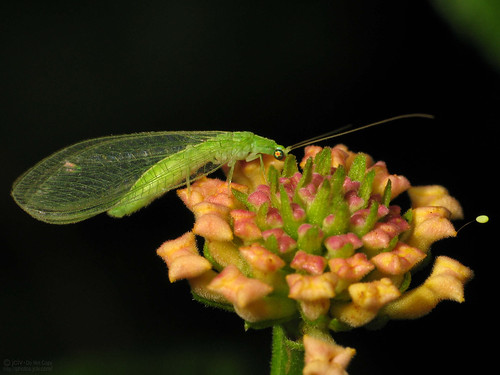
This year was my first time ever finding a lacewing in my garden. I was probably more excited than any normal human being should be. Of course in all my excitement I wasn’t able to get a photo of it for this post, so I borrowed one from flickr.
Why was I so excited to find a lacewing? Well, they are a great beneficial insect. While the adults eat pollen and nectar, the larvae eat mites, insect eggs and small insects like aphids. Some adults do too, depending on the species. Other beneficial insects we have come across in our garden include praying mantids, lady bugs, lots of lady bugs, soldier beetles, predaceous ground beetles, spiders, syrphid flies, thread-waisted wasps, and tachinid flies.
We have a very hands-off approach to dealing with most insect pests. We know we’re going to lose some stuff to insects and we know that our food isn’t going to be shiny-grocery-store-pristine, but isn’t that why we’re growing our own food? So we know what has, or should I say has not, been sprayed on it? There are a few pests that we do deal with somewhat – specifically slugs and snails which are a huge problem for us in the Spring. For them we simply use Sluggo around our seedlings. We do not, however, use Sluggo Plus which also works for earwigs and pillbugs. Sluggo Plus contains spinosad, which is highly toxic to bees and since we have digger bees in our garden which are in contact with our soil and our honeybees sometimes get water from our drip irrigation, I feel it’s best to just avoid using spinosad.
Other than snails and slugs there aren’t really any other bugs we contend with (we do kill aggressive wasps and their nests though because they can kill a beehive if they are so inclined). After years of trying different things we’ve learned to adjust the timing of our plantings to miss some pests like leafminers. We have cucumber beetles, squash bugs, stink bugs, and cutworms – just to name a few – but none of these have a very large population. Ones we come across get hand picked and fed to the chickens but otherwise we just don’t spray.
What we do to keep populations down is work on creating a balance between beneficials and pests. If we spray and kill all the pests, the beneficials leave and won’t be there when the pests come back. By keeping everything in balance by not spraying we keep the pest population down and just live with losing a small portion of our crops. We work on attracting beneficials by creating a habitat for them – we leave a portion of our yard a little wild. This creates cover for them and also acts as a “trap crop” for some of the pests. Some people would call this area “weedy” but it’s usefulness goes so far beyond it’s looks.
As I mentioned in a recent post, we’re going to be doing a garden makeover. It’s going to be a combination of “free-range chicken/turkey” and beneficial insect garden with some edibles thrown in for good measure. Stay tuned!


I laughed when you said that you got excited about seeing the lacewing in your garden. That sounds like me. I haven’t seen one in my garden but I’m keeping a watch out. I’m making an effort to learn about the insects that I find in my garden. Is it friend or a foe? Hope you find more lacewings and other beneficials in your garden!
Oh exciting! This is the first year I’m seeing ladybugs in my garden. Our property has needed some recovery time from the last owners. I can’t wait to start seeing more good critters around.